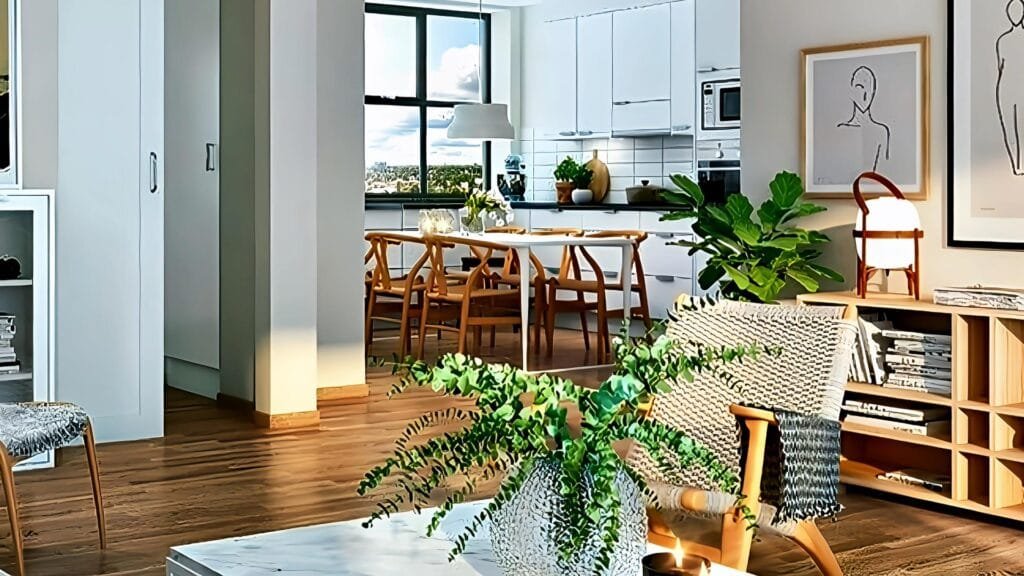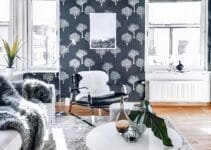Discover the core principles of Scandinavian interior design, emphasizing simplicity, functionality, and natural materials. Learn how to create a cozy and inviting atmosphere with neutral color palettes, clean lines, and a blend of beauty and practicality. Transform your apartment into a serene sanctuary with these expert tips.
Understanding Scandinavian Design Principles
Scandinavian interior design is renowned for its simplicity, functionality, and minimalist approach. Rooted in the cultural and historical context of the Nordic countries, this design philosophy emphasizes practicality and comfort while maintaining a clean and uncluttered aesthetic. The core principles of Scandinavian design revolve around the use of natural materials, neutral color palettes, and clean lines, all of which contribute to creating a cozy and inviting atmosphere.

The essence of Scandinavian design lies in its ability to blend beauty with functionality. Every piece of furniture and decor serves a purpose, ensuring that spaces are both aesthetically pleasing and practical. This approach stems from the harsh climates and long winters common in Nordic regions, where the need for warmth and comfort is paramount. Consequently, designers prioritize elements that enhance the living experience, such as ergonomic furniture, ample storage solutions, and multi-purpose items.
Please read our article watch the newly uploaded video from our YouTube channel:
“Grig Stamate – Interior Design Solutions”
https://www.youtube.com/@GrigStamate
How to Create a COZY SCANDINAVIAN Interior Design Apartment, #5 (video)
Here, you can see other related videos from our channel:
How to Create a COZY SCANDINAVIAN Interior Design Apartment, #4 (video)
How to Create a COZY SCANDINAVIAN Interior Design Apartment, #3 (video)
Natural materials play a significant role in Scandinavian interiors, reflecting a deep connection to the surrounding environment. Wood, often light in color, is a predominant material, used in everything from flooring and furniture to decorative accents. Textiles like wool, linen, and cotton add layers of texture and warmth, while also adhering to the natural theme. These materials not only enhance the aesthetic appeal but also promote sustainability and durability.
Neutral color palettes are another hallmark of Scandinavian design. Shades of white, gray, beige, and soft pastels create a serene and harmonious backdrop, allowing natural light to permeate and brighten the space. This use of light colors helps to combat the dimness of long winter months and creates an airy and open feel. Accents of black or muted tones can be used sparingly to add contrast and depth without overwhelming the simplicity of the design.

Clean lines and uncluttered spaces are fundamental to achieving the minimalist look characteristic of Scandinavian interiors. Furniture and decor items are typically sleek and streamlined, with an emphasis on geometric shapes and functional design. This approach not only maximizes space but also fosters a sense of calm and order, essential for a cozy living environment.
Incorporating these principles into your interior design can transform your apartment into a sanctuary of comfort and style, echoing the timeless appeal of Scandinavian aesthetics. By embracing simplicity, functionality, and natural elements, you can create a space that is both inviting and practical, perfectly suited to modern living.
Choosing the Right Color Palette
Selecting the appropriate color palette is a foundational step in achieving a cozy Scandinavian interior design for your apartment. The hallmark of Scandinavian design is its emphasis on simplicity, functionality, and beauty, which is often reflected in its color schemes. The use of neutral tones such as whites, grays, and beiges plays a crucial role in creating a calm and serene environment.
Whites serve as the primary color, offering a clean, bright backdrop that amplifies natural light and makes spaces appear larger and more open. Grays and beiges complement the whites by adding depth and warmth, ensuring that the space does not feel too clinical or sterile. These neutral tones work harmoniously to establish a peaceful and inviting atmosphere, which is essential for a cozy Scandinavian interior.
While neutral tones form the basis of the color palette, incorporating subtle pops of color through accessories and textiles can inject warmth and personality into the space. Consider using soft pastels or muted hues such as dusty pinks, soft blues, and gentle greens. These colors can be introduced through cushions, throws, rugs, and artwork, adding a layer of interest without overwhelming the simplicity of the design.
Balancing light and dark shades is another key aspect of achieving a harmonious Scandinavian interior. For instance, dark gray or black accents can be used sparingly to create contrast and define certain areas, such as window frames, picture frames, or furniture legs. This balance prevents the space from looking too monochromatic and adds visual depth.
To maintain a cohesive and inviting atmosphere, ensure that the overall color scheme is consistent throughout the apartment. By thoughtfully selecting and balancing neutral tones with carefully chosen accents, you can create a cozy Scandinavian interior that is both stylish and serene.
Incorporating Natural Materials and Textures
Scandinavian interior design is celebrated for its emphasis on simplicity, functionality, and a connection to nature. A cornerstone of this aesthetic is the use of natural materials and textures. These elements not only bring warmth and comfort to a space but also foster a serene and inviting atmosphere. Wood, leather, wool, and other organic materials are integral to creating a harmonious and cozy environment.
Wood is perhaps the most prominent material in Scandinavian design. Light-toned woods like pine, oak, and birch are favored for their ability to brighten spaces and add a sense of airiness. Wooden furniture, flooring, and accents bring an earthy warmth that is both visually appealing and tactile. The natural grains and knots in the wood also introduce an element of texture that enhances the overall aesthetic.
Leather and wool are equally important in this design style. Leather adds a touch of sophistication and durability, making it perfect for items like armchairs, sofas, and ottomans. Its rich, natural hues complement the lighter wood tones, creating a balanced and cohesive look. Wool, on the other hand, brings a soft, inviting texture that is ideal for throws, cushions, and rugs. The tactile quality of wool can make a space feel more intimate and cozy, especially in colder climates.
Mixing and matching different textures is key to adding depth and interest to a Scandinavian-inspired interior. Pairing smooth surfaces with rough, soft with hard, and matte with glossy can create a dynamic yet harmonious environment. For example, a sleek wooden table can be softened with a woolen runner, while leather chairs can be accented with knitted cushions.
To further enhance the cozy feel, incorporating plants and greenery is essential. Plants not only purify the air but also bring a touch of nature indoors, which is a fundamental aspect of Scandinavian design. Simple potted plants, hanging greenery, or a small indoor garden can make a significant impact. The lush green hues contrast beautifully with the neutral palette typical of Scandinavian interiors, adding vibrancy and life to the space.
By thoughtfully integrating natural materials and textures, you can create a Scandinavian interior that is both stylish and inviting. The use of wood, leather, wool, and greenery will ensure your space remains warm, tactile, and connected to nature.
Lighting plays a pivotal role in crafting the cozy ambiance that is synonymous with Scandinavian interior design. The hallmark of this design style is its reliance on natural light, which not only illuminates the space but also enhances its simplicity and tranquility. To maximize the influx of natural light, sheer curtains are recommended. Their translucent nature allows light to filter through while maintaining a level of privacy. Additionally, strategically placed mirrors can amplify the natural light, reflecting it throughout the room and creating a brighter, more inviting atmosphere.
When natural light is insufficient, the selection of the right artificial lighting becomes crucial. Pendant lights are a staple in Scandinavian interiors, often characterized by their minimalist design and warm glow. These lights can serve as focal points in living areas or above dining tables, providing both function and aesthetic appeal. Floor lamps, particularly those with adjustable arms, offer versatility in directing light where it is needed most, making them ideal for reading nooks or cozy corners.
A unique aspect of Scandinavian design is the use of candles to enhance warmth and coziness. Placing candles on windowsills, coffee tables, or shelves can add a subtle, flickering light that embodies hygge, the Danish concept of comfort and contentment. However, modern LED candles can be a safer alternative, providing the same ambiance without the risk of open flames.
Layering different light sources is essential to achieving a balanced and cozy ambiance. Combining overhead lights with task lighting and accent lights ensures that each area of the room is well-lit and functional. This layered approach not only adds depth to the space but also allows for flexibility in adjusting the lighting to suit different activities and moods. By thoughtfully integrating natural and artificial light, one can create an inviting and serene Scandinavian interior that exudes warmth and comfort.
Other related posts from our website:
Let’s see here, three of them:
https://howtobuildahouseblog.com/the-50-most-popular-scandinavian-style-apartments-so-far-in-2024/
https://howtobuildahouseblog.com/how-to-create-a-cozy-scandinavian-interior-design-apartment-4/
https://howtobuildahouseblog.com/inside-look-exploring-2-cute-apartments-with-scandinavian-vibes/
Thank you so much for your attention.
We also sincerely hope you like our ideas from this post, and you have also enjoyed our uploaded YouTube video.
See you next time at another article.
Thank you so much for your time. Bye now!

![Small Dreamy Family Homes [NORDIC STYLE] #9 Small Dreamy Family Homes [NORDIC STYLE] #9](https://howtobuildahouseblog.com/wp-content/uploads/2025/01/toddler-wearing-white-tank-top-near-white-wall-scaled.jpg)

No Responses